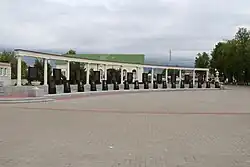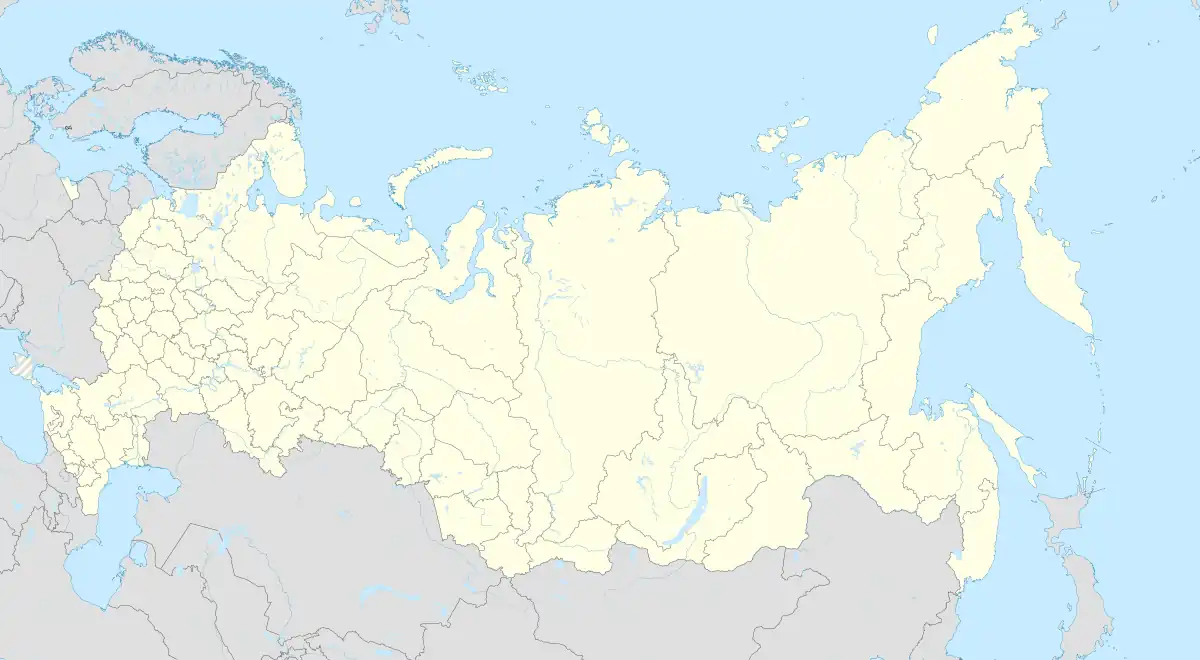Ponyri, Ponyrovsky District, Kursk Oblast
Ponyri
Поныри | |
|---|---|
 A square in Ponyri. | |
 Ponyri Location within Russia | |
| Coordinates: 52.313520°N 36.302621°E | |
| Country | Russia |
| Oblast | Kursk Oblast |
| District | Ponyrovski District |
| Population (2015)[1] | |
| • Total | 4,801 |
| • Estimate (2016) | 4,803 |
Ponyri is an urban-type settlement in the Ponyrovsky District of the Kursk Oblast. It has been famous for its apples, known as Antonovskiye Yabloki (English: Antonov's apples [variety])[2] In the Soviet era it largely consisted of two state farms (sovkhozi), Ponyri 1 and 2.[3] In English-language publications it is sometimes referred to as Ponyri Station, due to its location on the railway between Oryol and Kursk.[4] Population: 4,916 (2021 Census);[5] 4,791 (2010 Census);[6] 4,697 (2002 Census);[7] 4,941 (1989 Census).[8]
Great Patriotic War
Following the Nazi invasion, Ponyri was not under threat of occupation until late October, 1941, when the German XXXXVIII Motorized Corps pushed through against minimal resistance but while enduring minimal supplies and appalling weather on its way to Kursk.[9]
Ponyri remained under German occupation until February, 1943. In the course of the Soviet winter counter-offensive on the southern half of the front, following their victory at Stalingrad, elements of Bryansk Front's 48th and 13th Armies liberated the settlement on February 9.[10] The Soviet advance was brought to a halt in late February with the lines several kilometres north of Ponyri, and they began to dig in, at first as a matter of course, and then more seriously as a summer German offensive was anticipated.
Battle of Kursk
The north shoulder of the Kursk salient was defended by 13th Army of Gen. K.K. Rokossovsky's Central Front in the first line. On April 21, Rokossovsky was ordered by STAVKA to evacuate the civilian population from the frontal zone to a depth of 25 km, including Ponyri, so as to adapt the evacuated towns, villages and settlements for defense.[11]
The first attacks on Ponyri came from the air on the first morning of the battle. Rokossovsky had anticipated that the main German 9th Army attack would come straight down the rail line, but in fact it struck somewhat farther west, and he scrambled to get reserves into place. The 3rd Tank Corps was deployed to the south of Ponyri in the afternoon,[12] as well as the 3rd and 4th Guards Airborne Divisions, in support of the 307th Rifle Division.[13]
On the following days the 9th and 18th Panzer Divisions gradually pushed into Ponyri, at great cost to both sides. The German writer, Paul Carell, described it as "the Stalingrad of the Kursk salient." The 307th fiercely contested the schoolhouse, the water tower, the train and the field tractor stations. The 1023rd Rifle Regiment hung on to the high ground of Hill 253.5, just to the south of the settlement, and by July 11 the German forces were stuck fast, many kilometres from their objectives.[14]
References
- "Ponyri". Citypopulation.de. January 2015. Retrieved 28 January 2016.
- Robin Cross, The Battle of Kursk, Penguin Books, London, 1993, p 84
- David M. Glantz, After Stalingrad, Helion & Co., Ltd., Solihull, UK, 2009, pp 239, 245
- Glantz & Jonathan House, When Titans Clashed, University Press of Kansas, Lawrence, KS, 1995, p 166
- Russian Federal State Statistics Service. Всероссийская перепись населения 2020 года. Том 1 [2020 All-Russian Population Census, vol. 1] (XLS) (in Russian). Federal State Statistics Service.
- Russian Federal State Statistics Service (2011). Всероссийская перепись населения 2010 года. Том 1 [2010 All-Russian Population Census, vol. 1]. Всероссийская перепись населения 2010 года [2010 All-Russia Population Census] (in Russian). Federal State Statistics Service.
- Russian Federal State Statistics Service (21 May 2004). Численность населения России, субъектов Российской Федерации в составе федеральных округов, районов, городских поселений, сельских населённых пунктов – районных центров и сельских населённых пунктов с населением 3 тысячи и более человек [Population of Russia, Its Federal Districts, Federal Subjects, Districts, Urban Localities, Rural Localities—Administrative Centers, and Rural Localities with Population of Over 3,000] (XLS). Всероссийская перепись населения 2002 года [All-Russia Population Census of 2002] (in Russian).
- Всесоюзная перепись населения 1989 г. Численность наличного населения союзных и автономных республик, автономных областей и округов, краёв, областей, районов, городских поселений и сёл-райцентров [All Union Population Census of 1989: Present Population of Union and Autonomous Republics, Autonomous Oblasts and Okrugs, Krais, Oblasts, Districts, Urban Settlements, and Villages Serving as District Administrative Centers]. Всесоюзная перепись населения 1989 года [All-Union Population Census of 1989] (in Russian). Институт демографии Национального исследовательского университета: Высшая школа экономики [Institute of Demography at the National Research University: Higher School of Economics]. 1989 – via Demoscope Weekly.
- David Stahel, The Battle for Moscow, Cambridge University Press, Cambridge, UK, 2015, pp. 60-61, and map on p. 57
- Glantz, p. 245
- Dr. Boris Sokolov, Marshal K.K. Rokossovsky, Helion & Co., Ltd., Solihull, UK, 2015, p. 242
- Cross, p. 164
- Nikolai Litvin, 800 Days on the Eastern Front, trans. and ed. by Stuart Britton, University Press of Kansas, Lawrence, KS, 2007, pp. 16-17
- Cross, pp. 197-88. Note that Cross mistakenly identifies the rifle regiment as the 1032nd.